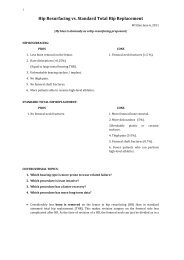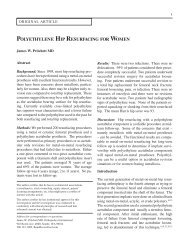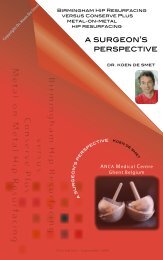Hip and Knee Arthroplasty - Surface Hippy Guide to Hip Resurfacing
Hip and Knee Arthroplasty - Surface Hippy Guide to Hip Resurfacing
Hip and Knee Arthroplasty - Surface Hippy Guide to Hip Resurfacing
You also want an ePaper? Increase the reach of your titles
YUMPU automatically turns print PDFs into web optimized ePapers that Google loves.
HIP REPLACEMENT<br />
GENERAL INTRODUCTION<br />
This report is based on the analysis of 191,673<br />
primary <strong>and</strong> revision hip replacements received<br />
by the Registry with a procedure date up <strong>to</strong> <strong>and</strong><br />
including 31 st December 2007. This is an<br />
additional 31,333 hip procedures compared <strong>to</strong><br />
the Annual Report released in 2007.<br />
Categories of <strong>Hip</strong> Replacement<br />
The Registry categorises hip replacements as<br />
either primary or revision procedures. Primary<br />
hip procedures are further categorised as partial<br />
or <strong>to</strong>tal hip replacements. Partial hips are further<br />
sub-categorised depending on the type of<br />
prostheses used; these are monoblock, unipolar<br />
modular <strong>and</strong> bipolar procedures. This year<br />
partial resurfacing has been included as an<br />
additional category of partial hip replacement.<br />
Partial resurfacing procedures involve the use of<br />
the Hemicap prosthesis, which has recently been<br />
introduced <strong>to</strong> the market in Australia. To the 31 st<br />
December 2007, the Registry has recorded the<br />
use of this prosthesis in eight hip replacements.<br />
Total hip replacements are categorised as either<br />
conventional <strong>to</strong>tal, <strong>to</strong>tal resurfacing or thrust<br />
plate procedures.<br />
Revision procedures are re-operations of hip<br />
arthroplasty. They may be primary partial,<br />
primary <strong>to</strong>tal or previous revisions <strong>and</strong> are<br />
categorised as major or minor. A major revision<br />
involves the removal <strong>and</strong>/or replacement of a<br />
major component, which is defined as a<br />
component that interfaces with bone i.e. either<br />
the femoral stem or acetabular cup or shell. A<br />
minor revision is a revision where a major<br />
component has not been removed or replaced.<br />
Examples of this include exchange of the femoral<br />
head <strong>and</strong>/or acetabular insert. A re-operation<br />
that does not involve removal, replacement or<br />
addition of a prosthesis or cable is not regarded<br />
as a revision procedure <strong>and</strong> therefore is not<br />
included in the analysis.<br />
A complete breakdown of age, gender, primary<br />
diagnosis <strong>and</strong> revision diagnoses for each<br />
category of hip replacement is available in a<br />
supplementary report on the Registry website<br />
www.aoa.org.au/jointregistry_pub.asp.<br />
Gender<br />
<strong>Hip</strong> replacements are performed more frequently<br />
in females (56.7%) than males. There are also<br />
variations in gender depending on the category<br />
of hip replacement. Primary partial hips (73.7%)<br />
<strong>and</strong> primary <strong>to</strong>tal hips (53.1%) are undertaken<br />
more frequently in females. Total resurfacing<br />
<strong>and</strong> thrust plate procedures are undertaken more<br />
frequently in males (72.7% <strong>and</strong> 70.9%<br />
respectively). More females have revision<br />
procedures (54.1%) (Table HG1).<br />
Since 2003 (the first year the Registry had full<br />
national coverage) there has been little change in<br />
the proportion of females having primary<br />
conventional hip replacement. There has<br />
however been a decline in females undergoing<br />
partial hip replacement (decreased from 75.4%<br />
in 2003 <strong>to</strong> 71.4% in 2007) <strong>and</strong> <strong>to</strong>tal resurfacing<br />
procedures (decreased from 28.8% in 2003 <strong>to</strong><br />
23.6% in 2007) (Figure HG1).<br />
Age<br />
The mean age for all hip replacement procedures<br />
is 69.9 years with females having a higher mean<br />
age compared <strong>to</strong> males (71.8 years <strong>and</strong> 67.4<br />
years respectively). Primary partial hips are<br />
generally used in individuals much older than<br />
those receiving primary <strong>to</strong>tal hips (mean age<br />
81.6 years for partials <strong>and</strong> 67.0 years for <strong>to</strong>tals).<br />
Females have a higher mean age for both of<br />
these procedures (82.0 years compared <strong>to</strong> 80.6<br />
years for males for partials, <strong>and</strong> 68.6 years<br />
compared <strong>to</strong> 65.2 years for males having primary<br />
<strong>to</strong>tal hips).<br />
Total resurfacing <strong>and</strong> thrust plate procedures are<br />
generally undertaken in people younger than<br />
those having primary conventional <strong>to</strong>tal hip<br />
replacement (<strong>to</strong>tal resurfacing 53.5 years, thrust<br />
plate 56.6 years <strong>and</strong> conventional 68.1 years).<br />
The mean age for revision procedures is 70.8<br />
years (females is 71.5 years <strong>and</strong> males is 70.1<br />
years).<br />
The different types of primary partial hip<br />
replacement are rarely undertaken on individuals<br />
less than 65 years of age (4.5%) with the<br />
exception of partial resurfacing where all<br />
procedures were undertaken on individuals less<br />
than 55 years of age.<br />
Most primary conventional hip replacements are<br />
undertaken on individuals 65 years or older but<br />
the proportion of younger than 65 years (34.3%)<br />
is much higher than for partial hip replacement.<br />
Most individuals having the other two types of<br />
primary <strong>to</strong>tal hip replacement are younger than<br />
65 years (90.3% for <strong>to</strong>tal resurfacing procedures<br />
15






